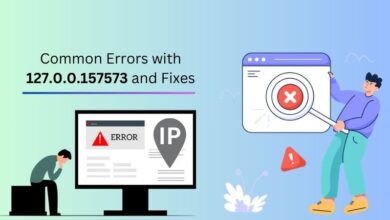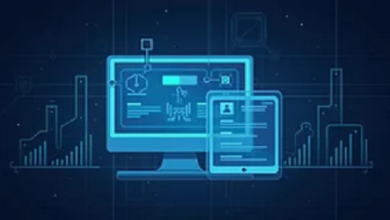Cybersecurity Trends: Staying Ahead in a Digital World

Due to the ever-changing nature of the digital threat environment, people and organizations face new hurdles in protecting sensitive information.
Since cyber-attacks are becoming more common, there are significant risks involved. Therefore, it’s critical to keep up with the latest advances in cybersecurity.
In this post, we will examine the latest trends in digital threats and provide insightful tips on how to stay ahead of these ever-changing threats.
The Emerging Cybersecurity Trends
Artificial Intelligence and Machine Learning
Artificial intelligence (AI) and machine learning (ML) are growing in cybersecurity, helping companies improve their ability to identify and address threats more efficiently.
These technological advancements aim to detect cyber threats by sifting through mountains of data for unusual patterns. Algorithms driven by artificial intelligence may automate incident response procedures, discover trends and abnormalities that point to malicious behavior, and evaluate massive volumes of data in real-time.
Data Breaches
Data intrusions remain a significant concern for individuals and organizations worldwide, as even minor software defects can create potential vulnerabilities. Regulative frameworks designed to improve data protection and privacy rights underscore the significance of rigorous security measures.
It is crucial to ensure compliance with these standards and employ proactive security measures to restrict the risks connected with data breaches.
The Rise of Ransomware Attacks
Ransomware attacks have increased substantially every year, posing an enormous risk to people and businesses. The encryption employed by this malware prevents access to critical data until the attack’s perpetrators are compensated with a ransom. Phishing emails, malicious attachments, or hacked websites often distribute ransomware.
To protect against this increasing threat, a defensive system with many layers is necessary. This system includes regular backups of essential data, resilient endpoint protection solutions, and comprehensive email security procedures to screen out harmful data.
The Importance of Zero Trust Architecture
Modern security models commonly work based on the premise that all elements inside a company’s network are reliable. Nevertheless, this method needs to be revised in the present-day networked society. Consider these phrases:” Never trust, always verify,” the Zero Trust paradigm has become more popular as a more efficient security technique.
No matter where a user or device tries to access resources, a zero-trust architecture will always verify them. Critical parts of this strategy include implementing strong identity and access management (IAM) systems, micro-segmentation, and multi-factor authentication (MFA). Implementing Zero-Trust principles may significantly lessen the likelihood of illegal access and data breaches for businesses.
The Internet of Things (IoT) Vulnerabilities
The growing use of Internet of Things (IoT) devices brings convenience, connectivity, and new security risks. Internet of Things (IoT) devices, including smart home devices, wearables, and industrial sensors, are often designed to emphasize utility rather than security.
Therefore, fraudsters might gain unauthorized access or start attacks by exploiting weaknesses in various IoT devices. Protecting Internet of Things (IoT) devices from these threats requires frequently updating firmware, separating IoT networks from mission-critical systems, and changing default passwords.
The Shift to Cloud Security
Cloud computing’s scalability, flexibility, and cost-efficiency have revolutionized company operations, leading to its broad acceptance. However, the change has brought with it new security concerns. Data processing and storage in the cloud require a distinct data security strategy than conventional on-premises systems.
Organizations must implement cloud-specific security procedures, such as data encryption, safe access restrictions, and ongoing cloud environment monitoring. Choosing trustworthy cloud service providers that follow strict security guidelines is also critical. As more companies move to the cloud, sensitive data protection will depend on maintaining strong cloud security.
The Rise of Quantum Computing
Improving cybersecurity using quantum-resistant encryption algorithms is a promising area for quantum computing. The increased processing capacity of quantum computers makes traditional encryption methods insecure since they depend on the computational complexity of certain mathematical problems.
By leveraging quantum mechanics, new cryptographic protocols, known as post-quantum cryptography, are being developed to withstand attacks from classical and quantum computers. This advancement ensures that sensitive information remains protected even as quantum computing becomes more mainstream.
Automotive Cybersecurity Threats
Modern cars have sophisticated software that provides advanced functions like engine timing, cruise control, driver aid systems, and seamless communication.
Nevertheless, cars are equally vulnerable to hacking because they depend on automation and communication. Hackers may take control of a car by listening in on conversations using built-in microphones via weaknesses in communication technologies such as Bluetooth and Wi-Fi.
As the use of automated cars becomes more widespread, the risks connected to them are projected to increase. Strong cybersecurity safeguards must be implemented, especially for self-driving or autonomous vehicles.
The Role of Cybersecurity Awareness Training
One of the most common reasons for security breaches is human error. Cybersecurity awareness training is crucial for educating personnel about possible dangers and the best ways to maintain security. Email phishing, social engineering, password hygiene, and secure web surfing are some subjects that should be included in effective training programs.
Adding simulated assault exercises and routinely updating training materials to reflect the most recent threats may increase the efficacy of these programs. Businesses that create a security-conscious culture inside the firm may also dramatically lower the likelihood of human-related security events.
The Growing Concern of Supply Chain Attacks
A rising number of organizations are falling victim to supply chain assaults, in which hackers try to breach their systems by exploiting weaknesses in their supply chain.
Organizations must conduct extensive security evaluations on suppliers and partners to reduce supply chain risks. Implementing strict security guidelines for third-party providers and routinely checking their compliance may help limit the risk of supply chain threats.
Collaboration and information exchange with industry peers may help improve overall supply chain security.
Cybersecurity Strategies: Best Practices
Cybersecurity is a dynamic and complicated field; businesses and people must take preventative measures and follow established protocols to succeed.
In terms of cybersecurity, some critical best practices are:
- Security Awareness: Conducting cybersecurity training for employees about new threats, phishing assaults, and social engineering strategies. Practice security awareness training regularly to allow employees to identify and report possible risks. Also, by providing tools to identify security issues and take appropriate action, organizations may improve their overall security posture and lower the chance of human error.
- Threat Intelligence: Utilize threat intelligence sources to stay updated with the most recent attack vectors, emergent malware, and criminal techniques. Use this data to improve your safety measures and incident response capabilities.
- Vulnerability Management: Implement a robust program to detect and address security flaws in your systems and applications. To determine the efficiency of your defenses, scan and fix vulnerabilities regularly and perform penetration testing.
- Security Assessments and Audits: You should conduct audits and assessments regularly to find security flaws, evaluate security measures, and ensure your business follows all the rules and regulations. Conducting security risk assessments, vulnerability scans, and penetration tests is crucial to determine how well security measures work and where they may be improved.
- Incident Response Planning: Create and regularly update an incident response plan, including security issue detection, response, and recovery processes. Test the plan’s efficacy and ensure employees are ready to react quickly and efficiently in case of a cyber-attack by conducting frequent tabletop exercises.
- Security Automation: By embracing automation and orchestration solutions, security processes may be streamlined, response times reduced, and overall efficiency improved. Automate mundane jobs like log analysis and incident triaging to make room for proactive threat research.
- Collaboration: Interact with other professionals in your field, exchange threat data, and work together to develop best practices. If you want to know what cybercriminals are up to now and how to stop them, you should join cybersecurity forums, groups, and information-sharing programs.
Final Thoughts
Staying ahead in the digital world demands ongoing awareness and adaptability, especially as cyber-attacks become more complex. By being aware of the most recent developments in cybersecurity and taking preventative action, individuals and organizations can safeguard their sensitive data and remain resilient against cyberattacks.
The cybersecurity trends covered in this blog highlight important areas requiring investment and effort to avoid new dangers. By being aware of these tendencies and acting proactively, we can create a more safe and robust digital environment for ourselves and future generations. Maintaining our knowledge and taking initiative will help us negotiate the constantly changing digital environment and protect our digital future.





